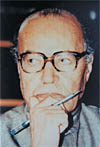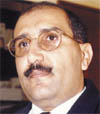Hamoud Baider to the YT: Yemen has solved its problems and now it is time to devote herself to development and progress [Archives:2000/39/Interview]
Mr. Hamoud Mohammed Baider was among those patriotic nationalists who fought against the Imams tyranny during the Arab Liberation Movement in the 1950s. He was born in 1942 in Sanaa. He was brought up in Sanaa where he also
got his education. He was coeval with the events of Suez Canal nationalization in 1956 and the declaration of the Arab Unity between Egypt and Syria in 1958.
Before the revolution, he was imprisoned with other patriots like Ali Abdulghani, Al-Sharai and many others. In 1958 he joined the Military Academy where his military skills were molded. He was haunted by the ideas of freedom and liberation which developed inside him a sense of determination to overthrow the Imam regime. So he joined the Revolutionary Officers Movement in their fight against the then Imams government until his dream came true in 1962. Mohammed Ben Sallam of the Yemen Times met him and listened to him as he recalled his memories with the first spark of the revolution:
Q: You took part in the Revolution against the Imam in 1962 and participated in drawing up its 6 goals. How did you come out with those goals? Do you think that they all have been fulfilled? Can they be guidelines for our new generations?
A: A number of Yemeni army officers and I met before the revolution and we decided to organize our activities against the Imam. At the same time we outlined the six goals which all were based on the situation of the people at the time. The north was ruled by a tyrant and the south was under the yoke of colonization and Sultans affiliated to the colonizers. The six goals were the gist of the political thought we believed in at the time.
Although we were in Sanaa and we had not been to Aden, Taiz, Sa’dah, etc. patriotism made us feel that all were constituting our country situated in the south of the Arab Peninsula. Therefore, the revolutions goals were confirming that the Yemeni cause was the same be it in Sanaa or Aden or Taiz, etc.
When the revolution broke out in 1962 the British colonizers tried in vain to block it. Many people from the south: Dahlia, Lahj, Abyan, Mukalla, Shabwah, Maharah, etc. rushed to congratulate us for the revolution led by Abdullah Al-Sallal and they joined us in protecting the newly-born revolution.
Q: Can you brief us on the revolution stages and the difficulties it had faced? Was there a role for the revolution in the North in eruption of the south revolution?
A: Just a year following the revolution in the north, the south revolution broke out in Radfan under the leadership of Rajeh Labbozah. That was the spark for the great revolution in 1964 which drove the last colonizer out of the country.
We believed that with the eviction of the last British colonizer from the south land, the two Yemens would be soon united. However, that was not fulfilled owing to the conspiracies against the revolution of the north resulting in the besiege after the Egyptian forces were pulled out following the War of 1967. Yemens enemies thought that Sanaa would collapse under the siege and that Aden would be occupied again by the Britishers. But they were stronger to fall down.
The two Yemens remained apart due to conflicts resulting form different political tendencies. Both sides were claiming the right to rule the whole country. This conflict continued until 1990 after extensive talks and meetings. This historic event was crowned by a referendum during which Yemenis approved the constitution and blessed the establishment of the unity.
In my opinion, the May 22 1990 marked the biggest revolution ever in the history of Yemen because it ended the serial of Yemenis struggle for unity.
Q: How do you assess the achievements after the revolution? Do you think that what has been achieved is satisfactory? Has there been a smooth progress since the revolution without any difficulties?
A: Let me ask a question; how was Yemen before 1962 and how is it now? What did the Sultans and Imams did during centuries? What has been accomplished in 38 years following the revolution? What has been achieved in a decade since unification?
Answers should come from those familiar with Yemen before 1962 and are still alive. There can not be any comparison between that time and now. This does not necessarily mean that all miracles have happened because you know that Yemen has faced a lot of conspiracies and challenges. There have been debates and controversies even among those who led the revolution and this helped soft-pedal Yemens progress. If Yemenis at this stage can achieve the largest part of the goals, that can be an achievement by itself.
The revolution outlined crystal-clear goals that we, the old generation, still believe in and will be sticking to until we die. That they are abided by or not is not to be talked about because if there are some shortcomings they should be attributed to mechanisms of execution and people concerned.
Q: How can you assess that different phases the revolution went through? What were the characteristics of each phase?
A: Since its eruption the revolution has undergone various difficulties. After the revolution, Yemen became a republic. Leaders of the new system differed over many issues. However, the republic has never collapsed.
Yemen has built a lot of big institutions, that none can deny, in a very short period depending on its limited resources. You can feel the difference in the number of students now and after the revaluation for example. In addition, there was no physician or any others with specialization except one engineer, Abdullah Al-Kurshomi, who graduated from Cairo at the time.
The problem in Yemen is disagreements among the political forces. Such disagreements are one of the main reasons for conflicts which affected the progress and development process. Despite all this, I can say that what has been achieved so far is very satisfactory.
I am sure that Yemen nowadays is more capable than before of accelerating the development process, specially with the emergence of gas and oil.
Q: There has been a disagreement among historians over recording the revolution, specially in regards to the nature of the revolutionary officers movement. How can you explain that?
A: It is something natural. Opponents of the Imam were many and they came from different parts of Yemen with different visions. But it was the revolutionary officers movement including, civilians, military personnel and tribesmen that could overthrow the tyrants.
Q: Any last words?
A: Yemen has solved its problems and now it is time to devote herself to development and progress. I am very optimistic about the future of Yemen. Yemenis are capable of standing strong and facing all the challenges. The most important thing that Yemen should focus on is democracy, freedom of thought and opinion, equality among people and justice.
——
[archive-e:39-v:2000-y:2000-d:2000-09-25-p:./2000/iss39/intrview.htm]


